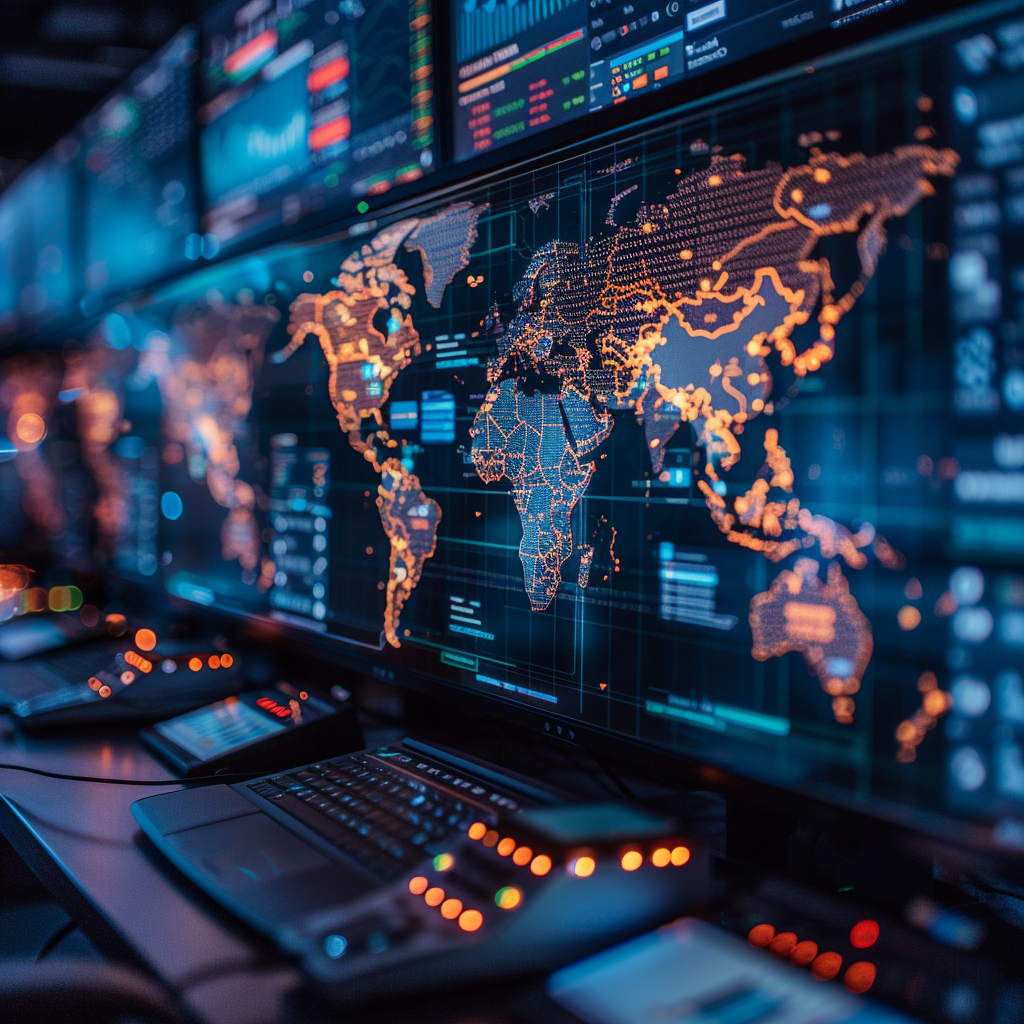1. Threat Detection
AI-driven threat detection systems can analyze vast volumes of network and log data in real time to identify malicious patterns far faster than traditional methods. By learning from past incidents, machine learning models can recognize new or evolving threats (including zero-day exploits) that signature-based tools might miss. This proactive detection capability is crucial as cyber attacks grow in volume and sophistication, enabling organizations to catch breaches earlier in their lifecycle. Reducing detection time helps limit damage, since the quicker a threat is discovered, the sooner defensive measures can be activated. Overall, AI enhances threat visibility across an organization’s infrastructure, augmenting human analysts by filtering noise and prioritizing the most critical alerts.

In 2023, a global survey of cybersecurity professionals found that nearly 60% of respondents identified improved threat detection as the most significant benefit of incorporating AI into their cybersecurity operations. This was the top-ranked advantage of security AI, slightly ahead of other benefits like accelerated incident response or better vulnerability management. The finding underscores that security teams value AI’s impact on detection capabilities above all, reflecting the urgent need to spot attacks more reliably amid an expanding threat landscape. As cyber threats become more complex, organizations are leaning on AI tools to sift through billions of events and flag anomalies in seconds. The result is a noticeable improvement in early breach identification, which can markedly reduce the time attackers have to operate undetected in networks.
2. Behavioral Analytics
Behavioral analytics in cybersecurity involves using AI to establish baselines of normal user and entity behavior and then detect anomalies that could indicate insider threats or account compromises. This approach is critical because not all threats come from malware or external hackers—sometimes authorized users acting maliciously or under duress can cause breaches. AI-enhanced behavioral monitoring can flag unusual login times, atypical access to sensitive data, or abnormal transaction patterns that deviate from a user’s typical profile. By catching subtle signs of misuse or compromised credentials, organizations can respond to insider incidents before they escalate. In essence, AI-driven behavioral analytics adds an intelligent layer of defense focused on who is doing what, helping to prevent data leaks and unauthorized activities from within.

Insider-related incidents have become a major concern, accounting for nearly 60% of all data breaches in 2024. This statistic, reported in Verizon’s 2024 Data Breach Investigations Report, highlights the prevalence of threats originating from internal users or misuse of legitimate access. It includes both malicious insiders and inadvertent errors, underscoring why robust internal monitoring is so important. AI-based behavioral analytics tools address this challenge by detecting anomalies in user behavior that could signal an insider attack. By 2025, many organizations have increased investments in User and Entity Behavior Analytics (UEBA) solutions to mitigate the risk posed by trusted insiders, given that the majority of breaches now involve some form of insider activity. The goal is to catch unusual patterns (like large data downloads or access from unusual locations) in real time, thereby reducing the impact of insider threats.
3. Incident Response
AI is transforming incident response by enabling faster, more automated reactions to detected threats. In a security incident, every minute counts, and AI-powered response tools (often part of SOAR – Security Orchestration, Automation, and Response) can isolate infected machines, block malicious IPs, or rollback changes almost instantly after an alert. This significantly reduces the window of opportunity for attackers. AI can also assist in incident analysis, triaging alerts and suggesting remediation steps based on learned attack patterns. By automating routine containment actions (such as quarantining a phishing-infected endpoint or disabling a compromised account), AI allows human responders to focus on complex decision-making and investigation. Ultimately, augmenting incident response with AI leads to a more resilient security posture, limiting damage and recovery time when breaches do occur.

Organizations with extensively deployed AI and automation in their cybersecurity program have been able to drastically shorten the lifecycle of security breaches. According to IBM’s 2023 data, companies using AI-driven incident response tools identified and contained breaches 108 days faster on average than those without such automation (214 days vs. 322 days). This is a substantial improvement — roughly a one-third reduction in time — which can mean the difference between a contained incident and a widespread compromise. Faster incident response not only reduces the dwell time of attackers but also curbs the overall cost and impact of a breach. In financial terms, IBM’s study also found that automating incident response and other security tasks lowered breach costs by millions of dollars. These statistics reinforce how critical AI and automation have become in accelerating response times and mitigating harm during cyber incidents.
4. Vulnerability Management
AI-enhanced vulnerability management helps organizations cope with the enormous volume of software vulnerabilities discovered each year. Rather than relying solely on periodic scans and manual analysis, AI systems can continuously scan code, applications, and networks to pinpoint weaknesses. More importantly, they can prioritize vulnerabilities by assessing factors like exploitability in the wild, potential impact, and exposure in the specific environment. This prioritization is crucial because large enterprises may have tens of thousands of vulnerabilities identified, but not all pose equal risk. By using machine learning to learn from past attacks and patch data, AI can predict which vulnerabilities are most likely to be targeted next. This allows security teams to focus their patching efforts on the issues that matter most, thereby reducing the organization’s true risk exposure. In sum, AI brings efficiency and intelligence to vulnerability management, ensuring critical flaws don’t get lost in the noise.

Improved vulnerability management is widely recognized as a key benefit of applying AI in cybersecurity. In the same 2023 industry survey, 57% of cybersecurity professionals reported that enhanced vulnerability prioritization and management was a major benefit of AI adoption. This was the second-highest rated benefit (just behind threat detection) in the survey, indicating that more than half of respondents see value in how AI can streamline the process of finding and fixing security weaknesses. The need for this is reinforced by the growing number of new vulnerabilities reported annually – over 26,000 were disclosed in 2023, a record high. Given this overload, organizations are increasingly turning to AI-based tools to automatically correlate vulnerability data with threat intelligence, reducing false positives and focusing on the most critical patches. The 57% survey figure shows a strong consensus that AI helps manage the vulnerability deluge more effectively, ultimately lowering the likelihood of unpatched flaws leading to breaches.
5. Phishing Detection
Phishing remains one of the most common attack vectors, and AI is being leveraged to improve detection rates of phishing emails and websites. Traditional email filters rely on blocklists and simple rules, but modern phishing attacks often use cleverly crafted messages that evade such filters. AI-based phishing detection uses natural language processing and image analysis to examine the content and structure of emails for signs of fraud – for example, analyzing sender reputations, looking for anomalous phrasing or misspellings, and detecting fake login forms or logos in attachments. AI can also learn from the continual stream of phishing attempts, adapting to new tactics (such as AI-generated phishing content). By deploying machine learning models in email gateways and browsers, organizations can catch phishing lures that humans might fall for. This significantly reduces the risk of credential theft and malware infections, as AI filters out malicious emails or links before they reach end-users.

The scale of the phishing threat is enormous, reinforcing the need for AI-driven detection. As of 2023, roughly 1.2% of all emails sent daily were malicious phishing emails, which works out to about 3.4 billion phishing emails every single day. This statistic, attributed to the Anti-Phishing Working Group (APWG), illustrates the sheer volume of phishing attempts circulating globally. With such a high baseline of malicious email traffic, even a tiny fraction evading detection can result in millions of phishing messages hitting inboxes. AI-powered filters have become essential: for instance, Google and other email providers report blocking hundreds of millions of phishing emails daily using machine learning algorithms. Thanks to these AI measures, many phishing attacks are stopped automatically; however, attackers continuously tweak their techniques, which drives continued enhancements in AI models. The 3.4 billion-per-day figure underscores that without intelligent automated detection, users would be inundated with fraudulent emails, drastically increasing breach incidents.
6. Network Security
In network security, AI is employed to monitor traffic patterns and device behaviors across an enterprise in real time. Traditional network monitoring systems generate many alerts for any anomalies, but AI can learn what “normal” network activity looks like (for a given time of day, application, or user) and then flag only truly suspicious deviations. This is particularly useful for detecting complex threats like advanced persistent threats (APTs) or botnet traffic that blend into regular traffic. AI systems can also help manage the response to network threats by dynamically reconfiguring network devices – for example, automatically throttling or blocking traffic when a potential Distributed Denial of Service (DDoS) attack is detected. The importance of AI in this domain has grown as corporate networks extend into cloud services and IoT devices, increasing complexity. Overall, AI provides a force multiplier for network defense, enabling rapid identification of intrusions, malware propagation, or data exfiltration that might be invisible to human analysts scanning logs.

One recent survey in 2024 found that monitoring network traffic is the number-one use case for AI in cybersecurity, cited by 54% of respondents. In other words, over half of the security leaders surveyed (in the United States) reported that they primarily use AI to analyze network traffic for threats. This reflects how prevalent AI-driven network anomaly detection has become in current security operations. By comparison, other use cases in the survey — such as using AI for generating defense playbooks or forecasting future attacks — were slightly less common, underlining that real-time network monitoring is where AI is delivering immediate value. The statistic aligns with industry trends: many companies have deployed AI-powered Network Intrusion Detection Systems (NIDS) and behavior analytics tools to cope with the huge volumes of network data. With 54% adoption in this area, it’s clear that AI-based network security monitoring has moved into the mainstream as a fundamental tool to quickly identify malicious activities like port scans, lateral movement, or beaconing to hacker servers.
7. Fraud Detection
AI-enhanced fraud detection is particularly vital in sectors like banking, e-commerce, and insurance. Machine learning models can analyze transaction data and user behavior in real time to discern patterns that might indicate fraudulent activity – for example, a sudden deviation in spending habits on a credit card, or an online purchase that doesn’t fit a user’s profile. Unlike static rule-based fraud systems (e.g., flagging transactions over a certain dollar amount), AI models learn from historical fraud cases to identify subtler signals, catching fraud that might slip through manual rules. They can cross-reference data points such as device used, geolocation, past transaction history, and even typing cadence (for online banking) to calculate a fraud risk score for each transaction or account login. When the risk is high, the system can automatically intervene (decline the transaction or require additional verification). The impact is significant: AI systems have reduced false declines of legitimate activity while improving the catch-rate of fraudulent transactions, saving companies and consumers billions of dollars that would otherwise be lost to fraud.

The financial sector has reported substantial successes using AI to combat fraud. In fiscal year 2023, Visa’s AI-powered risk systems prevented approximately $40 billion in fraudulent transactions worldwide. This figure, which almost doubled from the previous year, highlights the scale at which AI is safeguarding digital payments. Visa has long utilized machine learning models that analyze every credit and debit card transaction across its network (billions per day) within milliseconds, scoring them for fraud likelihood. In 2023, those models and associated AI tools blocked an unprecedented amount of would-be fraud, indicating how sophisticated fraud attempts have become and how crucial advanced analytics are in countering them. Other financial institutions and payment companies report similar trends: AI-based fraud detection tools are catching between 2x to 5x more fraudulent activities than older systems. The $40 billion saved in a single year by one company illustrates the broader industry impact — AI is now an indispensable weapon in reducing fraud losses and protecting consumers at scale.
8. Secure Authentication
Secure authentication is being bolstered by AI through methods like biometric verification and adaptive multi-factor authentication. Passwords alone are often weak links (prone to being guessed or stolen), so organizations are turning to biometrics (fingerprints, facial recognition, iris scans) and behavioral authentication (verifying users by how they type or move) — areas where AI is integral for accuracy. AI algorithms process biometric inputs and distinguish between legitimate users and imposters with high precision. Additionally, AI can enable risk-based authentication, where the system assesses login context (device, location, past behavior) and decides if additional verification is needed. For example, if a user’s login deviates from their normal pattern, the AI might trigger a one-time code or biometric check. Conversely, known and low-risk activities might face less friction. This intelligent, adaptive approach increases security (by making it extremely hard for attackers to masquerade as legitimate users) while preserving usability for genuine users. The net effect is fewer account breaches and reduced reliance on passwords, as AI-backed systems ensure that the person accessing a service is indeed who they claim to be.

The adoption of AI-based biometric authentication has surged in recent years, especially in the financial sector. As of 2023, about 83% of banking institutions worldwide have implemented at least one form of biometric authentication, a huge jump from just 35% in 2018. This statistic (reported by Juniper Research) reflects how mainstream biometrics have become for securing customer logins and transactions. Banks and fintech companies now commonly use fingerprint or facial recognition in their mobile apps, and some have introduced voice recognition for telephone banking or behavioral biometrics for continuous authentication. The rapid increase in adoption is driven by the dual promise of better security and user convenience — customers appreciate not having to remember complex passwords, while banks benefit from the reduced fraud and account takeovers that strong authentication provides. Beyond banking, a similar trend is seen in smartphones (almost all modern phones use fingerprint or face unlock, often powered by AI), workplaces (AI-based facial ID badges), and even airports. The 83% figure demonstrates a clear industry consensus that AI-enhanced authentication (especially biometrics) is far more secure than traditional credential-based approaches.
9. Automated Security Audits
Automated security audits involve using AI tools to continuously check an organization’s systems and configurations against security best practices and compliance requirements. Traditionally, security audits (for compliance standards like ISO 27001, PCI DSS, or internal policies) were periodic and manual, which meant issues could go unnoticed for long periods. AI changes this by enabling continuous control monitoring: for example, an AI system can regularly scan cloud configurations for misconfigurations, review user access rights for anomalies, or check software code for insecure patterns. These tools can automatically generate audit reports and even remediate simple issues (like reverting a risky configuration change). The benefit is twofold: it greatly reduces the manual workload on security teams and ensures that gaps are identified and addressed in near-real-time rather than at the next quarterly audit. Additionally, AI can correlate data from different audit domains (network, application, identity management) to provide a holistic view of compliance status. This leads to more robust security governance and easier demonstration of compliance to regulators and stakeholders.

Despite the clear advantages of automation, many organizations are still in early stages of adopting AI for security auditing and operations. According to IBM’s 2023 research, only 28% of companies reported extensive use of AI and automation in their cybersecurity programs, whereas 39% admitted to not using any security AI/automation at all. This indicates that less than a third of organizations have truly embraced automated solutions for tasks like security audits, incident response, and policy compliance, while a significant portion are lagging behind. Those that do utilize AI-driven security automation have seen tangible benefits, such as lower breach costs and faster compliance checks, but barriers like budget, skills, or trust in AI still slow broader adoption. The data suggests a strong potential for growth in this area: as AI tools mature and success stories spread, more organizations are expected to invest in automating their security audits and processes. In fact, Gartner predicts a sharp rise in adoption by 2025, with the majority of enterprises using some form of security automation platform. The current 28% adoption figure thus represents an early phase, with industry observers anticipating rapid growth in the coming years.
10. Advanced Encryption
Advanced encryption techniques are evolving to protect sensitive data against increasingly powerful threats, and AI plays a role both in developing stronger encryption and in managing cryptographic systems. One emerging challenge is the advent of quantum computing, which in the future could break current encryption algorithms (like RSA and ECC). To counter this, new post-quantum encryption algorithms are being standardized, and AI is helping optimize some of these algorithms for performance and security. Additionally, AI assists in encryption key management – for instance, predicting and preventing misconfigurations that could leak keys or automatically rotating keys based on usage patterns to minimize risk. AI can also detect weaknesses or potential backdoors in cryptographic implementations by learning from known vulnerabilities. On the flip side, adversaries might use AI to attempt to crack encryption through side-channel attacks or pattern analysis, which means defenders are also exploring AI to bolster encryption (such as AI-generated truly random number generators for keys). Overall, the intersection of AI and advanced encryption is about ensuring that as computation and threats advance, data remains confidential and integral, whether it’s in transit over networks or stored in the cloud.

We are witnessing the early adoption of quantum-resistant encryption protocols on the internet. By 2024, about 13% of all TLS 1.3 secure traffic was protected using post-quantum cryptography (PQ encryption), a notable jump as major browsers and platforms began enabling PQC by default. This statistic, reported in a Cloudflare network trend review, reflects the initial rollout of advanced encryption algorithms designed to withstand future quantum attacks. Throughout 2024, companies like Cloudflare, Google, and Apple started implementing post-quantum key exchange mechanisms (for example, in Chrome and iMessage), driving that percentage up from virtually 0% a few years prior to double digits. Reaching 13% of TLS 1.3 traffic is an early but important milestone, indicating that the tech industry is proactively upgrading encryption ahead of the quantum computing curve. Experts expect this number to continue rising rapidly as more internet services adopt the new standards; Cloudflare projected that adoption of post-quantum TLS could hit the majority of traffic within the next couple of years. The growth of PQ encryption deployment shows a collective effort to future-proof data confidentiality, and AI will likely play an increasing role in managing these complex cryptographic ecosystems at scale.